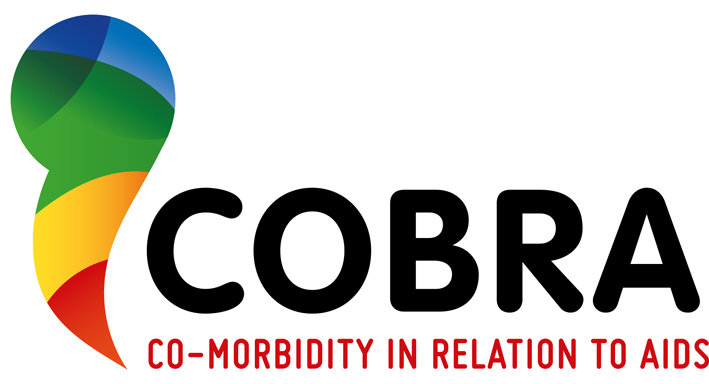COBRA
Co-morbidity in relation to AIDS


Objective
COBRA’s main objectives and underlying sub objectives are:
- To establish the link between HIV infection and age-associated non-communicable co-morbidities (AANCC).
1.1) To determine and compare the prevalence, incidence and outcomes of AANCC, including neurocognitive co-morbidity, in a cohort of middle-aged HIV-infected subjects with sustained HIV suppression on cART and similarly aged HIV-uninfected subjects, through comprehensive clinical and laboratory diagnostic means. - To elucidate and clarify this link by identifying its causative and underlying pathogenic mechanism(s)
2.1) To elucidate in the HIS mouse model the causative effect of HIV infection on metabolic changes which underlie certain AANCC in persons living with HIV.
2.2) To elucidate in the HIS mouse model the potential causative effect of cART on metabolic changes which underlie certain AANCC in persons living with HIV.
2.3) To clarify a number of possible pathogenic mechanisms, including the possible induction of an inflammation associated accelerated ageing phenol-type, underlying the causative link between HIV and AANCC through the use of a comprehensive range of biomarkers reflecting these mechanisms, in samples obtained from both the HIS mouse model and the clinical cohort.
Description
Persons with HIV on combination antiretroviral therapy (cART) are at increased risk of the premature development of age-associated non-communicable comorbidities (AANCC), including cardiovascular, chronic kidney, liver and pulmonary disease, diabetes mellitus, osteoporosis, non-AIDS associated malignancies, and neurocognitive impairment. It has therefore been hypothesised that such individuals, despite effective cART, may be prone to accelerated ageing. The underlying pathogenesis is likely to be multifactorial and include sustained immune activation, both systemically and within the central nervous system.
By building on an established infrastructure for conducting longitudinal HIV cohort studies in Amsterdam and London, we will provide a detailed, prospective evaluation of AANCC among HIV-infected patients suppressed on cART and appropriately chosen and comparable non-infected controls. In this way, we will provide a robust estimate of the effect of treated HIV infection on the prevalence, incidence and age of onset of AANCC, thus clearly establishing a link between HIV and AANCC.
Partners
AMC, Academic Medical Center (Netherlands)
Imperial College London (United Kingdom)
University of Gothenburg (Sweden)
UCL, University College London (United Kingdom)
Radboud Universiteit (Netherlands)
Alma Mater Studiorum-Universita Di Bologna (Italy)
Erasmus MC, Universitair Medisch Centrum Rotterdam (Netherlands)
VIB (Belgium)
Gemeente Amsterdam (Netherlands)
Universita degli Studi di Modena e Reggio Emilia (Italy)
Stichting HIV Monitoring (Netherlands)
Universitat Konstanz (Germany)
Funders
European Union’s Seventh Framework Programme
Countries
Netherlands
Germany
Belgium
United Kingdom
Italy
Sweden
